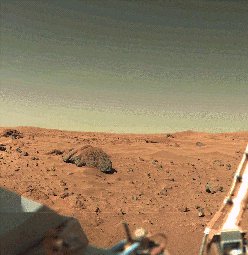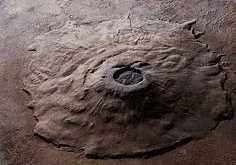MARS, THE GOD OF WAR

Mars is the last of the rocky inner planets. When seen in the night's sky Mars has a reddish colour and to the Roman's this fiery planet was the bringer of war.
Mars has probably caught the human imagination more than any other planet. In the 1870s it was incorrectly reported that canals had been observed on the Martian surface. Since then there has been much speculation about life on Mars. (see martians)
Although the canals never existed, Mars does have some interesting natural surface features. The reddish appearance of Mars is caused by red dust scattered across the Martian surface.

Winds sometimes whip up this dust and the entire planet can sometimes be enveloped in a red dust storm.
Ironically, it was during one of these storms, that astronomers found some of the most prominent features of Mars.
When the Mariner 9 space probe orbited Mars in 1971, the planet was in the midst of a large storm. As the storm subsided, several holes appeared in the dust clouds. Scientists realized that they were looking at several huge volcanoes.
The largest of these volcanoes is Olympus Mons (see below). At 15 miles high it is nearly three times the height of Everest and comparable in area to the size of Poland.

| Mars Statistics
|
|---|
|
|
|---|
| Equatorial radius (km) | 3,397.2
|
|---|
| Equatorial radius (Earth = 1) | 5.3264e-01
|
|---|
| Mean distance from the Sun (km) | 227,940,000
|
|---|
| Mean distance from the Sun (Earth = 1) | 1.5237
|
|---|
| Rotational period (hours) | 24.6229
|
|---|
| Rotational period (days) | 1.025957
|
|---|
| Orbital period (days) | 686.98
|
|---|
| Minimum surface temperature | -140°C
|
|---|
| Mean surface temperature | -63°C
|
|---|
| Maximum surface temperature | 20°C
|
|---|
| Atmospheric pressure (bars) | 0.007
|
|---|
Atmospheric composition
Carbon Dioxide (C02)Nitrogen (N2)Argon (Ar)
Oxygen (O2)Carbon Monoxide (CO)Water (H2O)Neon (Ne)
Krypton (Kr)Xenon (Xe)Ozone (O3)
95.32%
2.7%
1.6%
0.13%
0.07%
0.03%
0.00025%
0.00003%
0.000008%
0.000003%
| |
|---|
OBSERVING MARS
With the naked eye Mars will appear as a bright star with a reddish hue.
Viewed through a telescope Mars will appear as a bright orange but small disk. It should be possible in a small telescope to see one or both of the Martian polar caps. As Mars reached opposition in 2001 this was the closest we have been to the planet for over 10 years.
RELATED PAGES AT ASTROCENTRAL
Search for life on Mars
Search for life in the universe
Beagle 2 goes to Mars
The Martian Myth




